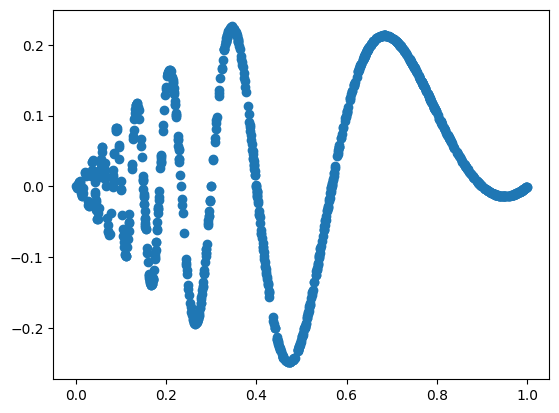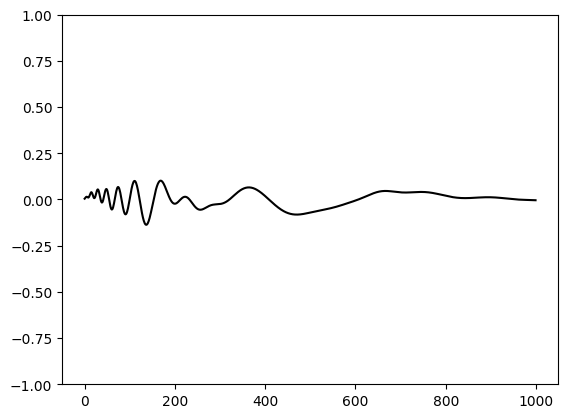'''This is a sample code for the simulations of the paper:
Bozorgasl, Zavareh and Chen, Hao, Wav-KAN: Wavelet Kolmogorov-Arnold Networks (May, 2024)
https://arxiv.org/abs/2405.12832
and also available at:
https://papers.ssrn.com/sol3/papers.cfm?abstract_id=4835325
We used efficient KAN notation and some part of the code:https://github.com/Blealtan/efficient-kan
'''
import torch
import torch.nn as nn
import torch.nn.functional as F
import torch.optim as optim
from torch.utils.data import DataLoader
from tqdm import tqdm
import math
class KANLinear(nn.Module):
def __init__(self, in_features, out_features, wavelet_type='mexican_hat'):
super(KANLinear, self).__init__()
self.in_features = in_features
self.out_features = out_features
self.wavelet_type = wavelet_type
# Parameters for wavelet transformation
self.scale = nn.Parameter(torch.ones(out_features, in_features))
self.translation = nn.Parameter(torch.zeros(out_features, in_features))
# Linear weights for combining outputs
#self.weight = nn.Parameter(torch.Tensor(out_features, in_features))
self.weight1 = nn.Parameter(torch.Tensor(out_features, in_features)) #not used; you may like to use it for wieghting base activation and adding it like Spl-KAN paper
self.wavelet_weights = nn.Parameter(torch.Tensor(out_features, in_features))
nn.init.kaiming_uniform_(self.wavelet_weights, a=math.sqrt(5))
nn.init.kaiming_uniform_(self.weight1, a=math.sqrt(5))
# Base activation function #not used for this experiment
self.base_activation = nn.SiLU()
# Batch normalization
self.bn = nn.BatchNorm1d(out_features)
def wavelet_transform(self, x):
if x.dim() == 2:
x_expanded = x.unsqueeze(1)
else:
x_expanded = x
translation_expanded = self.translation.unsqueeze(0).expand(x.size(0), -1, -1)
scale_expanded = self.scale.unsqueeze(0).expand(x.size(0), -1, -1)
x_scaled = (x_expanded - translation_expanded) / scale_expanded
# Implementation of different wavelet types
if self.wavelet_type == 'mexican_hat':
term1 = ((x_scaled ** 2)-1)
term2 = torch.exp(-0.5 * x_scaled ** 2)
wavelet = (2 / (math.sqrt(3) * math.pi**0.25)) * term1 * term2
wavelet_weighted = wavelet * self.wavelet_weights.unsqueeze(0).expand_as(wavelet)
wavelet_output = wavelet_weighted.sum(dim=2)
elif self.wavelet_type == 'morlet':
omega0 = 5.0 # Central frequency
real = torch.cos(omega0 * x_scaled)
envelope = torch.exp(-0.5 * x_scaled ** 2)
wavelet = envelope * real
wavelet_weighted = wavelet * self.wavelet_weights.unsqueeze(0).expand_as(wavelet)
wavelet_output = wavelet_weighted.sum(dim=2)
elif self.wavelet_type == 'dog':
# Implementing Derivative of Gaussian Wavelet
dog = -x_scaled * torch.exp(-0.5 * x_scaled ** 2)
wavelet = dog
wavelet_weighted = wavelet * self.wavelet_weights.unsqueeze(0).expand_as(wavelet)
wavelet_output = wavelet_weighted.sum(dim=2)
elif self.wavelet_type == 'meyer':
# Implement Meyer Wavelet here
# Constants for the Meyer wavelet transition boundaries
v = torch.abs(x_scaled)
pi = math.pi
def meyer_aux(v):
return torch.where(v <= 1/2,torch.ones_like(v),torch.where(v >= 1,torch.zeros_like(v),torch.cos(pi / 2 * nu(2 * v - 1))))
def nu(t):
return t**4 * (35 - 84*t + 70*t**2 - 20*t**3)
# Meyer wavelet calculation using the auxiliary function
wavelet = torch.sin(pi * v) * meyer_aux(v)
wavelet_weighted = wavelet * self.wavelet_weights.unsqueeze(0).expand_as(wavelet)
wavelet_output = wavelet_weighted.sum(dim=2)
elif self.wavelet_type == 'shannon':
# Windowing the sinc function to limit its support
pi = math.pi
sinc = torch.sinc(x_scaled / pi) # sinc(x) = sin(pi*x) / (pi*x)
# Applying a Hamming window to limit the infinite support of the sinc function
window = torch.hamming_window(x_scaled.size(-1), periodic=False, dtype=x_scaled.dtype, device=x_scaled.device)
# Shannon wavelet is the product of the sinc function and the window
wavelet = sinc * window
wavelet_weighted = wavelet * self.wavelet_weights.unsqueeze(0).expand_as(wavelet)
wavelet_output = wavelet_weighted.sum(dim=2)
#You can try many more wavelet types ...
else:
raise ValueError("Unsupported wavelet type")
return wavelet_output
def forward(self, x):
wavelet_output = self.wavelet_transform(x)
#You may like test the cases like Spl-KAN
#wav_output = F.linear(wavelet_output, self.weight)
#base_output = F.linear(self.base_activation(x), self.weight1)
base_output = F.linear(x, self.weight1)
combined_output = wavelet_output #+ base_output
# Apply batch normalization
return self.bn(combined_output)
class KAN(nn.Module):
def __init__(self, layers_hidden, wavelet_type='mexican_hat'):
super(KAN, self).__init__()
self.layers = nn.ModuleList()
for in_features, out_features in zip(layers_hidden[:-1], layers_hidden[1:]):
self.layers.append(KANLinear(in_features, out_features, wavelet_type))
def forward(self, x):
for layer in self.layers:
x = layer(x)
return xKANs with Wavelets
Replace B-Splines with Wavelets Following base code is taken from WavKAN and this notebooks on Wavelet Regression
Function Fitting
We will take some interesting test functions from Wavelet Regression notebook.
The Doppler function is \[ f(x) = x(1-x) \sin(\frac{2.1\pi}{x+0.05}) \\ x \sim U[0,1] \]
import torch
import matplotlib.pyplot as plt
import numpy as np
from kan.utils import create_dataset
torch.set_default_dtype(torch.float64)
device = torch.device('cuda' if torch.cuda.is_available() else 'cpu')
print('device is: ',device)
f = lambda x: x[:,[0]]*(1-x[:,[0]])*torch.sin((2*np.pi)/(x[:,[0]]+.1))
dataset = create_dataset(f, n_var=1, device=device, ranges=[0,1])
print('train input data shape', dataset['train_input'].shape)
print('train label data shape', dataset['train_label'].shape)
plt.scatter(dataset['train_input'],dataset['train_label'])device is: cpu
train input data shape torch.Size([1000, 1])
train label data shape torch.Size([1000, 1])
# Define model
import torch
import torch.nn as nn
import torch.optim as optim
from tqdm import tqdm
device = torch.device("cuda" if torch.cuda.is_available() else "cpu")
# create a KAN: 1D inputs, 1D output, and 5 hidden neurons.
model = KAN([1, 32, 1], wavelet_type='mexican_hat')
model.to(device)
# Define loss
learning_rate = 0.01
criterion = nn.MSELoss()
optimizer = torch.optim.Adam(model.parameters(),lr=learning_rate)def train_network(model,optimizer,criterion,X_train,y_train,X_test,y_test,num_epochs,train_losses,test_losses):
for epoch in range(num_epochs):
#clear out the gradients from the last step loss.backward()
model.train()
optimizer.zero_grad()
#forward feed
output_train = model(X_train)
#calculate the loss
loss_train = criterion(output_train, y_train)
#backward propagation: calculate gradients
loss_train.backward()
#update the weights
optimizer.step()
model.eval()
output_test = model(X_test)
loss_test = criterion(output_test,y_test)
train_losses[epoch] = loss_train.item()
test_losses[epoch] = loss_test.item()
if (epoch + 1) % 50 == 0:
print(f"Epoch {epoch+1}/{num_epochs}, Train Loss: {loss_train.item():.4f}, Test Loss: {loss_test.item():.4f}")
return model, train_losses, test_losses
import numpy as np
num_epochs = 1000
train_losses = np.zeros(num_epochs)
test_losses = np.zeros(num_epochs)
X_train = dataset['train_input']
y_train = dataset['train_label']
X_test = dataset['test_input']
y_test = dataset['test_label']
mlp, train_losses, test_losses = train_network(model,optimizer,criterion,X_train,y_train,X_test,y_test,num_epochs,train_losses,test_losses)Epoch 50/1000, Train Loss: 0.2128, Test Loss: 0.2410
Epoch 100/1000, Train Loss: 0.0273, Test Loss: 0.0248
Epoch 150/1000, Train Loss: 0.0039, Test Loss: 0.0032
Epoch 200/1000, Train Loss: 0.0020, Test Loss: 0.0018
Epoch 250/1000, Train Loss: 0.0014, Test Loss: 0.0018
Epoch 300/1000, Train Loss: 0.0012, Test Loss: 0.0014
Epoch 350/1000, Train Loss: 0.0011, Test Loss: 0.0014
Epoch 400/1000, Train Loss: 0.0010, Test Loss: 0.0013
Epoch 450/1000, Train Loss: 0.0009, Test Loss: 0.0014
Epoch 500/1000, Train Loss: 0.0009, Test Loss: 0.0020
Epoch 550/1000, Train Loss: 0.0009, Test Loss: 0.0035
Epoch 600/1000, Train Loss: 0.0008, Test Loss: 0.0038
Epoch 650/1000, Train Loss: 0.0008, Test Loss: 0.0026
Epoch 700/1000, Train Loss: 0.0008, Test Loss: 0.0027
Epoch 750/1000, Train Loss: 0.0009, Test Loss: 0.0010
Epoch 800/1000, Train Loss: 0.0008, Test Loss: 0.0010
Epoch 850/1000, Train Loss: 0.0008, Test Loss: 0.0035
Epoch 900/1000, Train Loss: 0.0008, Test Loss: 0.0039
Epoch 950/1000, Train Loss: 0.0010, Test Loss: 0.0027
Epoch 1000/1000, Train Loss: 0.0008, Test Loss: 0.0019# let us look at the recontruction
X = dataset['train_input']
n = 1000
X[:,0] = torch.linspace(0,1,steps=n)
y = f(X)
y = y[:,0].detach().numpy()
yh = model.forward(X)
yh = yh[:,0].detach().numpy()
plt.plot(y,color='blue')
plt.plot(yh, color='red')
plt.show()
plt.plot(yh-y, color='black')
plt.ylim(-1,1)
plt.show()
